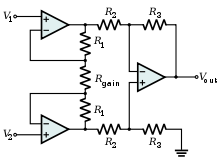- Common-mode rejection ratio
-
The common-mode rejection ratio (CMRR) of a differential amplifier (or other device) is the tendency of the devices to reject the input signals common to both input leads. A high CMRR is important in applications where the signal of interest is represented by a small voltage fluctuation superimposed on a (possibly large) voltage offset, or when relevant information is contained in the voltage difference between two signals. (An example is audio transmission over balanced lines.)
Ideally, a differential amplifier takes the voltages V + and V − on its two inputs and produces an output voltage Vo = Ad(V + − V − ), where Ad is the differential gain. However, the output of a real differential amplifier is better described as
where Acm is the common-mode gain, which is typically much smaller than the differential gain.
The CMRR is defined as the ratio of the powers of the differential gain over the common-mode gain, measured in positive decibels (thus using the 20 log rule):
As differential gain should exceed common-mode gain, this will be a positive number, and the higher the better.
The CMRR is a very important specification, as it indicates how much of the common-mode signal will appear in your measurement. The value of the CMRR often depends on signal frequency as well, and must be specified as a function thereof.
It is often important in reducing noise on transmission lines. For example, when measuring the resistance of a thermocouple in a noisy environment, the noise from the environment appears as an offset on both input leads, making it a common-mode voltage signal. The CMRR of the measurement instrument determines the attenuation applied to the offset or noise.
Example: operational amplifiers
An operational amplifier (op-amp) has two inputs, V+ and V-, and an open-loop gain G. In the ideal case, the output of an ideal op-amp behaves according to the equation
This equation represents an infinite CMRR: if both inputs fluctuate by the same amount (while maintaining a constant difference V+ - V-), this change will have no bearing on the output. In real applications, this is not always the case: the lower the CMRR, the larger the effect on the output signal, following the general equation
Where VCM represents the common-mode voltage at the inputs, or (V+ + V-)/2.
The 741, a common op-amp chip, has a CMRR of 90 dB, which is reasonable in most cases. A value of 70 dB may be adequate for applications which are insensitive to the effects on amplifier output;some high-end devices may use op-amps with a CMRR of 120 dB or more.
So for example, an op-amp with 90dB CMRR operating with 10V of common-mode will have an output error of ±316uV.
See also
- Signal-to-noise ratio
- Balanced line
- XLR connector
- Tip ring sleeve
External links
Categories:- Electronics terms
- Engineering ratios
Wikimedia Foundation. 2010.





